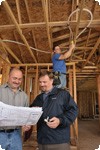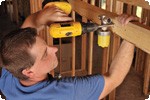
Most plumbers have never considered installing residential fire sprinklers. After all, how can a professional plumbing, heating and cooling contractor compete with fire sprinkler contractors who have a license, special equipment and complicated design knowledge?
“You’d be surprised how easy it can be to move from setting sinks to installing residential fire safety systems,” says Kelly Fahey, co-owner of Washington-based PacWest Sales Inc. “Plumbers already have the knowledge, tools and, more importantly, the solid working relationships with home builders to prosper in a market downturn.”
He notes that because plumbers are already a pivotal trade for builders, the market is ripe for PHC contractors to step up and claim this profitable line of work. The beauty of multipurpose fire safety systems, explains Fahey, is that because they combine the potable cold-water lines with the sprinkler system, they are a natural extension for the plumbing trade. A fire sprinkler connects to the plumbing-supply line just like any other fixture or fitting.
PacWest and Fahey represent Uponor, who was a pioneer of the concept of residential, nonstagnant, multipurpose systems in the United States a decade ago. Uponor AQUASAFE Fire Safety Systems - both the network version and its recently introduced looped version - use crosslinked polyethylene (PEX) tubing to feed both the sprinklers and the cold-water plumbing fixtures in a home.

Plumbing contractor Steve Svedarsky (left) credits Uponor
rep Kelly Fahey (right) with helping him to complete 20 fire sprinkler jobs and
to secure an additional 30 multi-family units - all in less than four months in
2007.
Low-Hanging Fruit
“Multipurpose fire safety systems are the low-hanging fruit for new-construction-oriented PHC contractors looking to squeeze more dollars from fewer jobs than in years past,” Fahey says. “Today, a plumber might do half the number of homes he did when the market was stronger. PHC contractors can recover some of this lost revenue by learning the basics of fire sprinkler installation and securing their first jobs in less than a month.”That’s precisely the path that plumbing contractor Steve Svedarsky took when the market showed signs of slowing last year.
“Like in any business, plumbers protect their turf,” explains the second-generation PHC contractor from Puyallup, Wash., and owner of Monarch Plumbing. “When we realized there was a shrinking pool of jobs, we had to figure out a way to expand our revenue base. Since we were already using PEX exclusively for our plumbing and radiant floor heating work, the fundamentals of sprinkler installation were very straightforward.”
For product training and design support, Svedarsky turned to Fahey, who not only had the industry knowledge, but also helped him convince the local fire marshal that PEX-fed multipurpose fire sprinkler systems performed as well as traditional stand-alone systems.
“The fire marshal was skeptical that the multipurpose system could deliver the required water volume to each of the sprinkler heads,” recalls Svedarsky. “After he learned more about the system from PacWest and watched it exceed his code requirements, the fire marshal was impressed and pleased. After all, fire sprinklers save the lives of both homeowners and fire fighters.”
In fact, Svedarsky has learned that some fire officials actually prefer multipurpose systems, since consumers cannot inadvertently shut off fire protection to their homes.
“Because of the dual purpose of combination systems, homeowners know their fire protection systems are working each time a toilet is flushed, a faucet is used or the lawn is watered,” says Svedarsky, who notes that this feature also eliminates health concerns over stagnant water commonly associated with stand-alone systems.
Mandated Demand
Overall, the addition of fire sprinkler installation has been a boon for Monarch and now accounts for roughly 10 percent of company sales. Owner Svedarsky credits Fahey with helping him to complete 20 sprinkler jobs and to secure an additional 30 multifamily units - all in less than four months in 2007.“Once plumbers have the required training and/or certification, it is hard to avoid the business,” contends Svedarsky. “While local codes drive the majority of the work, I know of four or five instances in which the PHC contractor sold sprinklers into a job as an upgrade where they were not required by code.”
Research from the Home Fire Sprinkler Coalition bears out these claims. A 2005 study found 45 percent of U.S. homeowners preferred a home with fire sprinklers; moreover, nearly three in four survey respondents thought sprinklers increased the value of a home.
Not surprisingly then, more than 300 local governments have enacted residential fire sprinkler ordinances for all new single- and multifamily residential homes, commonly referred to as National Fire Protection Association (NFPA) Standard 13D, according to Jayson Drake, fire safety product manager for Uponor. And the number of ordinances across the nation is likely to grow with recent revisions to the International Residential Code, which will require sprinklers in all new one- and two-family homes as of Jan. 1, 2011. (For additional information on this code provision, read Julius Ballanco’s column on page 64.)
“Demand will grow dramatically as more builders and homebuyers become aware of the quantifiable benefits of these systems,” says Drake. “This growth will also be fueled by jurisdictional mandates as cities and fire departments realize the economical, life-saving advantages of PEX-based multipurpose residential sprinkler systems.”
Drake notes that because multipurpose PEX systems combine plumbing and fire safety lines into the same integrated system that uses flexible PEX tubing with fewer connections, they can save from 35 to 65 percent in installation time over stand-alone, rigid CPVC systems. *
Moreover, since multipurpose systems are fed by a home’s domestic cold-water supply, there is no need for check valves, backflow preventers or a separate water meter, further cutting installation time and costs.

'Once plumbers have the required training and/or
certification, it is hard to avoid the [residential fire sprinkler] business,'
contends Steve Svedarsky.
Education Is Key
According to Fahey, educating local building inspectors and code enforcers about the benefits of multipurpose fire safety systems can be a challenge.“Some of the more foresighted municipalities have written ordinances allowing multipurpose fire protection systems to operate off of a single water meter, which enables the builder to realize a significant savings over traditional stand-alone installations, as a second meter can cost upwards of $5,000,” explains Fahey.
Another challenge in expanding residential fire safety systems is the piecemeal code requirements.
“Unlike the Uniform Plumbing Code that mandates a universal standard, NFPA 13D sets a minimum life-safety standard, and each municipality has the ability to add requirements unique to its jurisdiction,” notes Fahey, who adds that he keeps track of specific municipal requirements through an internal database.
“While the fire marshal often reviews the sprinkler plan and conducts the inspection, some states still allow the plumbing inspector or building department to approve the fire suppression system.”
* Source: U.S. Department of Commerce and the National Institute of Standards and Technology, NISTIR 7277.